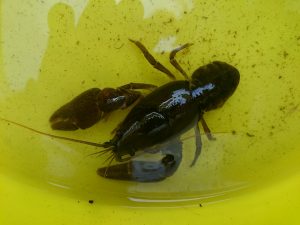The white-clawed crayfish – the UK’s only native crayfish – is under threat. It has suffered massive decline in recent years due to a combination of declining water quality and the invasive American signal crayfish.
The population of white-clawed crayfish in the River Culm is one of only two remaining in Devon. So we are working hard to discover more about the white-clawed crayfish in the River Culm and to find ways to protect it from extinction.
White-clawed crayfish facts
- The white-clawed crayfish (austropotamobius pallipes) have large pincers (claws) that are coloured cream or orangey-white on their underside; it is these distinctive claws which have given white-clawed crayfish their name.
- They are nocturnal creatures and aren’t very active during the winter, which means that this secretive invertebrate is rarely seen.
- One of the UK’s largest freshwater invertebrates, white-clawed crayfish can grow up to 12cm long.
- The white-clawed crayfish is the UK’s only native crayfish species. Other crayfish species have been introduced to the UK from other countries.
- Crayfish are omnivorous crustaceans – they eat everything from invertebrates to water plants and dead organic matter.
- White-clawed crayfish prefer habitats which offer them places to hide such as underwater tree roots, submerged vegetation and stony river beds.
- Crayfish need water that contains minerals to build their body armour (shell) just in the same way as we need calcium to grow teeth and nails.
- They have important roles in the freshwater environment because of their diet and they provide food for other animals such as fish, herons and otters.
- White-clawed crayfish are important indicators of good water quality as they are intolerant of pollution.
Crayfish videos
Culm Community Crayfish project
About Crayfish in the River Culm
Children’s animation about crayfish
Ongoing work to protect white-clawed crayfish
Read more about crayfish
Help protect white-clawed crayfish
There are some simple things that you can do to help to prevent the spread of crayfish plague. When you’re out and about near the river follow the ‘check, clean, dry’ code to stop the spread of crayfish plague.
- Crayfish plague can be easily spread between sites, for example on wet angling kit, dogs or footwear.
- Check your equipment and clothing for live organisms and mud that could carry crayfish plague spores.
- Clean and wash all equipment, footwear and clothes thoroughly.
- Dry all equipment and clothing – some species can live for many days in moist conditions.
- Make sure you don’t transfer water elsewhere.
Culm Community Crayfish Project
Through our Culm Community Crayfish project we led surveys to help us learn more about the native white-clawed crayfish, the invasive American signal crayfish and the river habitat in which they live.





